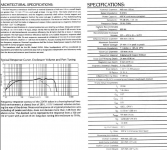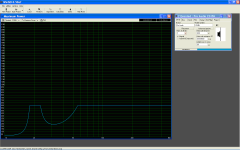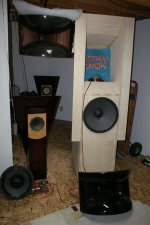Not a good choice unless you are thinking about a folded horn that would make your 10 cubic foot box look like a breadbox by comparison. 10 cubes is at the small end of what you want for a driver with a VAS of 29 cubic feet (820 L).Hi I have a JBL 2245 H that I put into a 10 cubic foot box tuned to 30 cycles.I am using it with Klipsh LaScala bass bins for the lower octave. I want to know if this driver could work well in a folded horn enclosure? or is it the wrong woofer for that ? thank you ,Scott
Attachments
Hi ON the JBL 2245 H The TS Parameters are: fs 20 qts .27 qms 2.2 qes .27 vas 821.2 eff 2.1 pe 300 x max 9.65 re 5.8 le 1.4 sd 0.130 bl 21 mms 185 flux 1.22 Any idea if i could build a folded horn with this driver.I have the tools and experience to build it I just need a drawing. and as far as size i have enough room for a say 3'x2.5' x6' .I should be able to get some decent horn length with something of that size?Thanx Scott
Scott,I should be able to get some decent horn length with something of that size?
Yes, it's possible to fold a very long horn in a cabinet with a gross volume of 43.5 cubic feet
Art
So how would i go about designing this. I have lots of 3/4" mdf and i can double and even triple the sheets to arrive at approx 1 1/2" or 2 1/4" thick walls and brace the heck out of it.My present enclosure sounds great with conventional speakers but seems a bit slow for the bass bin.Thank you for your experience and willingness to share same.Scott in beautiful Eugene ,Oregon
The free software Hornresp can help you design enclosures that fit the speaker parameters:
Hornresp for Dum... hmm... Everyone - Home Theater Forum and Systems - HomeTheaterShack.com
- Home Theater Forum and Systems - HomeTheaterShack.com
Model your 10 cubic foot cabinet first so you can compare the response of the horn design to it, and see if it's worth the work for the output (and size) increase.
The path length will be longer than your top cabinet- if you don't delay the tops, the LF will lag at the crossover point, which will sound "slow".
As it stands, using a Klipsh LaScala with the 18" would require time alignment at the crossover (or overlap) region to sound "tight".
Hornresp for Dum... hmm... Everyone
Model your 10 cubic foot cabinet first so you can compare the response of the horn design to it, and see if it's worth the work for the output (and size) increase.
The path length will be longer than your top cabinet- if you don't delay the tops, the LF will lag at the crossover point, which will sound "slow".
As it stands, using a Klipsh LaScala with the 18" would require time alignment at the crossover (or overlap) region to sound "tight".
Hi Scott
You’ve not specified exactly what you plan to use this driver for so I’ll just tell you of my experience where I’ve used the 2245 woofer in a 12cf ported enclosure tuned to 20 Hz.
It’s probably the best sounding woofer I’ve ever had, except that I wanted it for a subwoofer for my HT and that’s where I encountered its major weakness, its Xmax limit of ½ inch (9.5 cm). And when they say 9.5cm they mean 9.5cm not 9.6 because this speaker very easily bottoms out mechanically producing a very laud and frightening whapping sound, in fact in my enclosure this driver can only handle 18 watts at 10Hz.
In a horn enclosure you’ll have to use a low cut filter not to allow any signals below 25 Hz other than that it should sound great.
The other problem with this driver is that the foam tends to rot after a few years so you should expect to have to re-foam it every now and then.
Regards
PJC
You’ve not specified exactly what you plan to use this driver for so I’ll just tell you of my experience where I’ve used the 2245 woofer in a 12cf ported enclosure tuned to 20 Hz.
It’s probably the best sounding woofer I’ve ever had, except that I wanted it for a subwoofer for my HT and that’s where I encountered its major weakness, its Xmax limit of ½ inch (9.5 cm). And when they say 9.5cm they mean 9.5cm not 9.6 because this speaker very easily bottoms out mechanically producing a very laud and frightening whapping sound, in fact in my enclosure this driver can only handle 18 watts at 10Hz.
In a horn enclosure you’ll have to use a low cut filter not to allow any signals below 25 Hz other than that it should sound great.
The other problem with this driver is that the foam tends to rot after a few years so you should expect to have to re-foam it every now and then.
Regards
PJC
1983 JBL SUBWOFFER DESIGN
Will handle 1KW on program material if the amplifier cannot clip! (use an amplifier with a peak limiter).
A clipped 100W amp will make the woofer bottom out.
Will handle 1KW on program material if the amplifier cannot clip! (use an amplifier with a peak limiter).
A clipped 100W amp will make the woofer bottom out.
1983 JBL SUBWOFFER DESIGN
Will handle 1KW on program material if the amplifier cannot clip! (use an amplifier with a peak limiter).
A clipped 100W amp will make the woofer bottom out.
Hi djk
It doesn't matter if the amp clips or not, its almost all frequency dependent. Anything below a ported box resonance frequency more than 18 watts will bottom out a JBL 2245, the 2240 also had this problem. In fact if you run winISP you'll find that the power is even limited above the resonance frequency. JBL improved the situation with the 2241 & 2242 you just have to check the rear pole piece to see why. If you can manage the Xmax weakness (Hi-pass filter, Limiters, etc) the 2245 is really a great sounding driver, but a sub woofer for HT it is not, too bad because it was JBL's lowest playing 18" driver with a 20Hz FS.
PJC
(a one time long ago JBL service manager)
FWIW, I built a pair of the 10 cu ft boxes in the Greg Timbers article with the 2245H. They worked well and could shake the house before bottoming, but did indeed need a subsonic filter. IMO, I got a better result when I plugged up the ports, then equalized to a -3dB point at 20 Hz with a B4 acoustic (sum of electrical and box/driver) highpass. My ears ran out before the driver did.
Yes, refoaming was a regular task.
Yes, refoaming was a regular task.
FWIW, I built a pair of the 10 cu ft boxes in the Greg Timbers article with the 2245H. They worked well and could shake the house before bottoming, but did indeed need a subsonic filter. IMO, I got a better result when I plugged up the ports, then equalized to a -3dB point at 20 Hz with a B4 acoustic (sum of electrical and box/driver) highpass. My ears ran out before the driver did.
Yes, refoaming was a regular task.
Hi Sy
Always loved reading your comments and you've had some great ones (esp on your tube amps). I always make an effort to read a blog when I see the polar bear.
Did you run the 2245s with a tube amp or with a SS amp? Actually SS amps tend to better control the over excursion when clipping (so-called hard clipping) because the back EMF of the speaker gets shunted out to the power supply by the reverse polarity diodes across the output transistors producing a dynamic-brake effect, whereas tube amps don't have this D-B effect and thusly have a soft-clipping nature.
I agree with you 100% that a closed box would be better for the 2245 to help control the Xmax limit, however with a Vas of 29cf its motor structure was not really strong enough to get full performance out of a smaller box (in you case of 5 cf per driver), so the user had to resort to gain boosts and sharp filtering to produce the required sound while protecting the driver. By the way what was the roll-off of your filter?
In my case I had a 12cf box tuned to 20Hz for a single driver, and that one 2245 also shook the house but with no-filters or boost because I was trying to get a 15Hz low end for my HT which is where I failed. I had to change the driver before I destroyed it. Which is sad because I really liked it. I was considering adding a second driver and sealing the box as you did, but with the foam problems and the difficulty getting an original unit I decided it was not worth the risk.
For the fun it I tweaked the 2245 Xmax in winISP to allow a 1 inch excursion (instead of 9.5mm) and the predicted performance of this speaker would be hard to beat even by the best subs available today. Someone should perhaps think of building such an animal.
Keep up the good work
PJC
"Not so, and if you ask me nicely I will explain what is happening."
Sorry djk, I won't bother asking because I know very well what happens to a woofer when an amp clips both for solid state and for tubes, as I have been designing and characterizing amps (both tube, SS and micro-wave) since the late-sixties some have which have been used in recording studios.
A SS amp will attempt to stop (or brake) all of the cone's movement when it clips due to the reverse bias shunt diodes that are always used to protect the power transistors from the coil’s back EMF. If these diodes were not there the power output transistors could be destroyed by the back EMF voltage.
At the moment of clipping the cone's inertia produces a voltage that is greater than the clipped output of the amp and as such the speaker changes from a current load to a current generator and as I hope you are aware due to the laws of physics a current flowing back into the amp’s low impedance power supply looks like a short circuit on the coil thus forcing a dynamic brake action on the cone. Therefore clipping actually stops the cones movement with a SS amp.
This action causes the so-called Hard-Clipping sound that SS amps are known for. Tube amps on the other hand will tend to over push the cone on clipping as the back EMF voltage actually adds to the plate voltage that in turn raises the output voltage delaying somewhat the clipping and rounding out the sharp corners of the clipped signal.
Many people think that it’s the feedback / dampening factor that controls the speaker movement at clipping, but this is not true, because at clipping a feedback driven amplifier loses all dampening capability (i.e. cone control) and it’s the only the shunt diodes that rules under this condition.
I suggest that you should open any speaker software and model the JBL 2245 for yourself, you’ll be amazed to see how much frequency limits its power handling capability, it can only support full power (600 watts program / 300 watts RMS) at the box’s resonant frequency, its power capability drops both above (e.g. 238 program watts at 33 Hz) and below this frequency, and in my case, at 10Hz it only supports 18 watts before the Xmax limit is exceeded (see the supplied winISP chart I've supplied).
PJC
(A one time long ago JBL (Canada) service manager)
Sorry djk, I won't bother asking because I know very well what happens to a woofer when an amp clips both for solid state and for tubes, as I have been designing and characterizing amps (both tube, SS and micro-wave) since the late-sixties some have which have been used in recording studios.
A SS amp will attempt to stop (or brake) all of the cone's movement when it clips due to the reverse bias shunt diodes that are always used to protect the power transistors from the coil’s back EMF. If these diodes were not there the power output transistors could be destroyed by the back EMF voltage.
At the moment of clipping the cone's inertia produces a voltage that is greater than the clipped output of the amp and as such the speaker changes from a current load to a current generator and as I hope you are aware due to the laws of physics a current flowing back into the amp’s low impedance power supply looks like a short circuit on the coil thus forcing a dynamic brake action on the cone. Therefore clipping actually stops the cones movement with a SS amp.
This action causes the so-called Hard-Clipping sound that SS amps are known for. Tube amps on the other hand will tend to over push the cone on clipping as the back EMF voltage actually adds to the plate voltage that in turn raises the output voltage delaying somewhat the clipping and rounding out the sharp corners of the clipped signal.
Many people think that it’s the feedback / dampening factor that controls the speaker movement at clipping, but this is not true, because at clipping a feedback driven amplifier loses all dampening capability (i.e. cone control) and it’s the only the shunt diodes that rules under this condition.
I suggest that you should open any speaker software and model the JBL 2245 for yourself, you’ll be amazed to see how much frequency limits its power handling capability, it can only support full power (600 watts program / 300 watts RMS) at the box’s resonant frequency, its power capability drops both above (e.g. 238 program watts at 33 Hz) and below this frequency, and in my case, at 10Hz it only supports 18 watts before the Xmax limit is exceeded (see the supplied winISP chart I've supplied).
PJC
(A one time long ago JBL (Canada) service manager)
Attachments
Hmm, while what you say seems to make sense, actual observed cone excursion shows that the cone is moving at an intermodulation component of the pole in the feedback loop of the amplifier and the pole formed by the power supply filter caps and the speaker impedance.
This beat frequency is usually below 2hz, even though the crossover has an infrasonic filter at Fb.
This beat frequency is usually below 2hz, even though the crossover has an infrasonic filter at Fb.
Max, my apologies for being unclear. Each driver is in a separate 10 cu ft box.
Yes, I use solid state to run them- or I should say "used solid state" since my current (and final!) wife is very tolerant of my hobby but drew the line at those boxes. They currently sit in my basement lab. 500WPC of Class D did a very nice job. At one point, I modified them for servo operation, but didn't feel that I got much sonic benefit from it, so went back to "open loop" operation with EQ.
Yes, I use solid state to run them- or I should say "used solid state" since my current (and final!) wife is very tolerant of my hobby but drew the line at those boxes. They currently sit in my basement lab. 500WPC of Class D did a very nice job. At one point, I modified them for servo operation, but didn't feel that I got much sonic benefit from it, so went back to "open loop" operation with EQ.
Hi I have a JBL 2245 H that I put into a 10 cubic foot box tuned to 30 cycles.I am using it with Klipsh LaScala bass bins for the lower octave. I want to know if this driver could work well in a folded horn enclosure? or is it the wrong woofer for that ? thank you ,Scott
hi Scott, I too have JBL 2245's and thought it should be tried in a horn, back 2006 my first cabinet was enlarged K horn this made huge bass, I used it up to 60 hz. needed a four system way with it. and it was 400lbs
now I am working on a rear loaded horn that will free stand beside my video screen. (little more moveable), still large as any bass horn will be. I am into the first day of trial and so far it seems to be a seismic warrior the range is what amazes me ,it is much more than a sub, I can cross this at 800hz so two way is possible. it is 84 inch tall 30 deep 28 wide ,top top horn bell is a separate structure so the cabinet is split in half for moving Picture
Attachments
- Status
- This old topic is closed. If you want to reopen this topic, contact a moderator using the "Report Post" button.
- Home
- Loudspeakers
- Subwoofers
- JBL 2245 H


